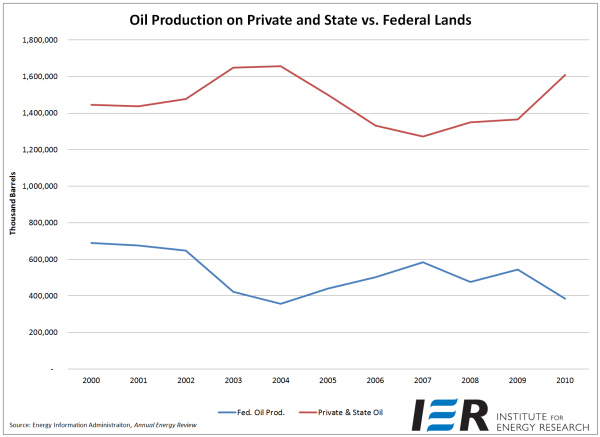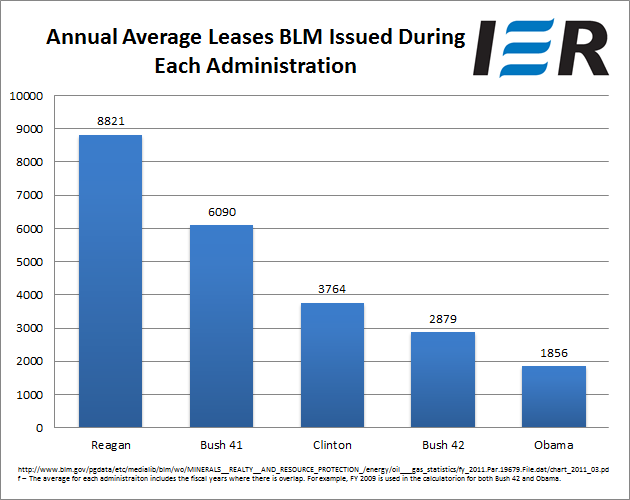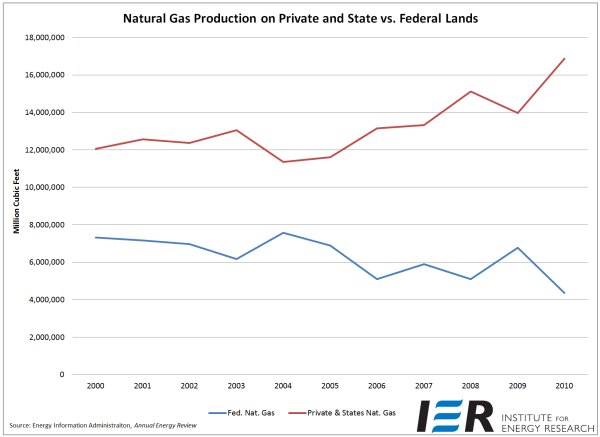The Obama campaign just released a website that purports to provide “the facts of President Obama energy record.” This is an intentional effort by the Obama campaign to distort the President’s abysmal energy record. After all, energy production on federal land is down under President Obama and the Obama campaign is trying their hardest to hide and obfuscate this basic fact.
Obama Claim: “Since President Obama took office, oil imports have been reduced by an average of 1.1 million barrels per day.”
Reality: A reduction of imports has happened without President Obama, not because of him. More than half of the reduction is because the ongoing recession and much higher price have made fuel so expensive that consumers are using less of it.
In January 2009, when President Obama was inaugurated, the U.S. produced 5,154,000 barrels of oil a day.[1] By November 2011, the last month for which we have data, the U.S. was producing 5,874,000 barrels of oil a day. This 700,000 barrel a day increase isn’t happening on federal lands, for which President Obama would justifiably claim some credit, but on private and state lands.
[**Update** The following paragraph cites data from the Energy Information Administration (EIA). EIA subsequently discovered that the data they used for determining oil and natural gas production numbers on federal lands were incorrect and they are working to fix the problem. The Department of Interior, which regulates energy production on federal lands, is working with EIA to develop a system that more adequately reflects production clearly, and we will update the oil and natural gas production charts when the federal government completes its coordination and updates its information.]
The reality is that oil production on federal lands is falling, while production on private and state lands is rising.[2] There is a long term trend of decreasing oil production on federal lands. In fact, oil production on federal lands has fallen by 43 percent over the past 9 years according to the Obama administration’s Energy Information Administration.[3] And it has dropped rapidly on President Obama’s watch.
In fact, because of the actions taken by the Obama administration such as severely limiting the offshore areas where oil can be produced, cancelling oil leases, and withdrawing other oil leases, oil production on federal lands will most likely continue to fall. (More of the Obama administration’s anti-energy actions can be found here.)
Not only is the Obama administration making it more difficult to produce energy on federal lands, they are leasing much less lands than the past. The following chart shows the decline in leasing on onshore lands over the past 30 years. This lack of leasing on federal lands will only result in lower production on federal lands in the future.
Obama Claim: 2010 domestic crude oil production reached its highest levels since 2003.
Reality: This is true, but the average production per day for 2011 is only 0.3 million barrels per day higher than in 2009. And, as noted above, the reason that U.S. crude oil production is increasing is because of production on private and state lands while production on federal lands is decreasing. The President cannot honestly take credit for the production on private and state lands, but he can take partial credit for decreasing production on federal lands.
Obama Claim: 2010 natural gas production reached its highest level in more than 30 years.
Reality: Yes natural gas production is up, but this is because of production on private and state lands because production on federal lands is decreasing. [4]
Obama Claim: The U.S. has become a net energy exporter.
Reality: This claim is 100 percent false. Because the Obama campaign does not provide a single citation or source for their information, it is impossible to know how great its ignorance of energy facts extends. Every year, the Energy Information Administration, which is part of the Obama administration’s Department of Energy, publishes an Annual Energy Review. If the Obama campaign understood energy facts, they would have looked at Table 1.4 of the 2010 Annual Energy Review. They would have found a table titled, “Primary Energy Trade by Source, Selected Years, 1949–2010.” That table shows that in 2010, far from being a net energy exporter, the U.S. had net imports of 21 quadrillion Btus of energy of the 98 quadrillion btus used.
Obama Claim: The Obama administration has proposed a five-year offshore drilling plan that makes more than 75 percent of undiscovered oil and gas resources off our shores available for development, while putting in place common-sense safety requirements to prevent a disaster like the BP oil spill from happening again.
 Reality: When President Obama was inaugurated nearly 100 percent of the offshore areas were available for exploration and development. Since then, the Obama administration has imposed limitations and made it far more difficult to produce energy on offshore areas. For example, even though there is bipartisan support from the Virginia delegation, including the state’s Democratic Senators, the Obama administration refuses to allow energy exploration off Virginia’s coast.
Reality: When President Obama was inaugurated nearly 100 percent of the offshore areas were available for exploration and development. Since then, the Obama administration has imposed limitations and made it far more difficult to produce energy on offshore areas. For example, even though there is bipartisan support from the Virginia delegation, including the state’s Democratic Senators, the Obama administration refuses to allow energy exploration off Virginia’s coast.
Politicians taking credit for something good happening on their watch is nothing new, but as we have shown, the reduction in oil use is because of economic dislocation visited upon millions of American families by the longest sustained economic downturn since World War II, while the increase domestic production is occuring on state and private lands, while production on government lands over which he has control is going down. In this sense, the president’s claims are simply breathtakingly in their apparent assumption that no one will bother to fact-check his numbers.
[1] Energy Information Administration, Monthly Energy Review, Table 3.1 Petroleum Overview, http://www.eia.gov/totalenergy/data/monthly/pdf/sec3_3.pdf.
[2] See Energy Information Administration, Annual Energy Review 2010, Table 1.14, Fossil Fuel Production on Federally Administered Lands, Selected Year 1949–2010, http://205.254.135.24/totalenergy/data/annual/pdf/sec1_31.pdf.
[3] Id.
[4] See Energy Information Administration, Annual Energy Review 2010, Table 1.14, Fossil Fuel Production on Federally Administered Lands, Selected Year 1949–2010, http://205.254.135.24/totalenergy/data/annual/pdf/sec1_31.pdf.






